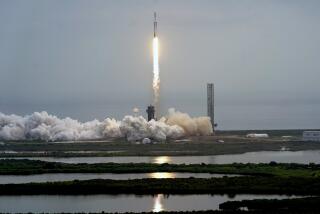Spacecraft Begins Quest for Comets
CAPE CANAVERAL, Fla. â NASA launched a spacecraft Wednesday on a mission to get within 60 miles of a comet nucleus to study frozen samples of the solar system from its infancy.
The craft, named Contour, for Comet Nucleus Tour, was launched atop a Boeing Delta 2 rocket from Cape Canaveral Air Force Station at 2:47 a.m. EDT.
NASA reported the spacecraft was in its proper orbit and working fine after launch.
âIt appears the mission is right on the mark. Weâre happy here,â said launch director Chuck Duvall.
Contour will orbit Earth until Aug. 15, when its rockets will send it toward an encounter with Comet Encke in 2003, then Comet Schwassmann-Wachmann 3 in 2006.
Contour is equipped with a special debris shield so it can navigate closer to the comets and survive bombardment from the minute particles of dust and frozen water that form a cometâs most distinctive feature, the tail.
The shield includes a layer of Kevlar, the material used in bulletproof vests, to help vaporize particles striking Contour with the force of .22-caliber bullets.
Contour will spend most of its operational life hibernating, NASA said, to hold down costs on the $158-million program.
During each of its passes near the comets, its four instruments will work for about six minutes, collecting hundreds of photographs and about two gigabytes worth of data.
Comets are common in the solar system--there may be trillions altogether, experts say--but most remain far beyond the orbit of Pluto, the outermost planet, and beyond the reach of scientists.
However, scientists remain interested because they believe each has a nucleus frozen about 4.6 billion years ago, at the time planets were forming, and may contain vital secrets.
Numerous theories, from the destruction of dinosaurs to the beginning of life on Earth, involve comets.
âComets are the solar systemâs smallest bodies, but among its biggest mysteries,â said Joseph Veverka of Cornell University.
Contour will return to the Earthâs orbit after studying the two comets and can be sent out again.






